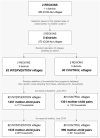Evaluation of an unconditional cash transfer program targeting children's first-1,000-days linear growth in rural Togo: A cluster-randomized controlled trial
- PMID: 33201927
- PMCID: PMC7671539
- DOI: 10.1371/journal.pmed.1003388
Evaluation of an unconditional cash transfer program targeting children's first-1,000-days linear growth in rural Togo: A cluster-randomized controlled trial
Abstract
Background: In 2014, the government of Togo implemented a pilot unconditional cash transfer (UCT) program in rural villages that aimed at improving children's nutrition, health, and protection. It combined monthly UCTs (approximately US$8.40 /month) with a package of community activities (including behavior change communication [BCC] sessions, home visits, and integrated community case management of childhood illnesses and acute malnutrition [ICCM-Nut]) delivered to mother-child pairs during the first "1,000 days" of life. We primarily investigated program impact at population level on children's height-for-age z-scores (HAZs) and secondarily on stunting (HAZ < -2) and intermediary outcomes including household's food insecurity, mother-child pairs' diet and health, delivery in a health facility and low birth weight (LBW), women's knowledge, and physical intimate partner violence (IPV).
Methods and findings: We implemented a parallel-cluster-randomized controlled trial, in which 162 villages were randomized into either an intervention arm (UCTs + package of community activities, n = 82) or a control arm (package of community activities only, n = 80). Two different representative samples of children aged 6-29 months and their mothers were surveyed in each arm, one before the intervention in 2014 (control: n = 1,301, intervention: n = 1,357), the other 2 years afterwards in 2016 (control: n = 996, intervention: n = 1,035). Difference-in-differences (DD) estimates of impact were calculated, adjusting for clustering. Children's average age was 17.4 (± 0.24 SE) months in the control arm and 17.6 (± 0.19 SE) months in the intervention arm at baseline. UCTs had a protective effect on HAZ (DD = +0.25 z-scores, 95% confidence interval [CI]: 0.01-0.50, p = 0.039), which deteriorated in the control arm while remaining stable in the intervention arm, but had no impact on stunting (DD = -6.2 percentage points [pp], relative odds ratio [ROR]: 0.74, 95% CI: 0.51-1.06, p = 0.097). UCTs positively impacted both mothers' and children's (18-23 months) consumption of animal source foods (ASFs) (respectively, DD = +4.5 pp, ROR: 2.24, 95% CI: 1.09-4.61, p = 0.029 and DD = +9.1 pp, ROR: 2.65, 95% CI: 1.01-6.98, p = 0.048) and household food insecurity (DD = -10.7 pp, ROR: 0.63, 95% CI: 0.43-0.91, p = 0.016). UCTs did not impact on reported child morbidity 2 week's prior to report (DD = -3.5 pp, ROR: 0.80, 95% CI: 0.56-1.14, p = 0.214) but reduced the financial barrier to seeking healthcare for sick children (DD = -26.4 pp, ROR: 0.23, 95% CI: 0.08-0.66, p = 0.006). Women who received cash had higher odds of delivering in a health facility (DD = +10.6 pp, ROR: 1.53, 95% CI: 1.10-2.13, p = 0.012) and lower odds of giving birth to babies with birth weights (BWs) <2,500 g (DD = -11.8, ROR: 0.29, 95% CI: 0.10-0.82, p = 0.020). Positive effects were also found on women's knowledge (DD = +14.8, ROR: 1.86, 95% CI: 1.32-2.62, p < 0.001) and physical IPV (DD = -7.9 pp, ROR: 0.60, 95% CI: 0.36-0.99, p = 0.048). Study limitations included the short evaluation period (24 months) and the low coverage of UCTs, which might have reduced the program's impact.
Conclusions: UCTs targeting the first "1,000 days" had a protective effect on child's linear growth in rural areas of Togo. Their simultaneous positive effects on various immediate, underlying, and basic causes of malnutrition certainly contributed to this ultimate impact. The positive impacts observed on pregnancy- and birth-related outcomes call for further attention to the conception period in nutrition-sensitive programs.
Trial registration: ISRCTN Registry ISRCTN83330970.
Conflict of interest statement
The authors have declared that no competing interests exist.
Figures



References
-
- Development Initiatives. Global Nutrition Report 2017: Nourishing the SDGs [Internet]. 2017 [cited 2019 Jun 20]. https://globalnutritionreport.org/reports/2017-global-nutrition-report/
-
- UNICEF, WHO, The World Bank. UNICEF-WHO-The World Bank: Joint child malnutrition estimates—levels and trends– 2020 edition [Internet]. 2020 [cited 2019 Jun 20]. https://data.unicef.org/resources/jme-report-2020.
-
- Victora CG, Adair L, Fall C, Hallal PC, Martorell R, Richter L, et al. Maternal and child undernutrition: consequences for adult health and human capital. [published correction appears in Lancet. 2008 Jan 26;371(9609): 302]. Lancet. 2008;371(9609): 340–357. 10.1016/S0140-6736(07)61692-4 - DOI - PMC - PubMed
Publication types
MeSH terms
Associated data
LinkOut - more resources
Full Text Sources
Medical
Miscellaneous

